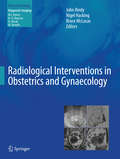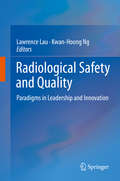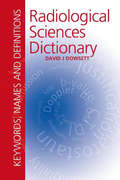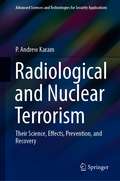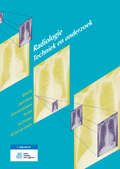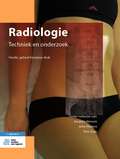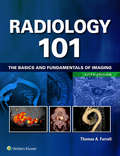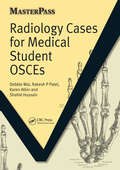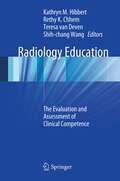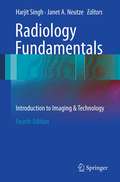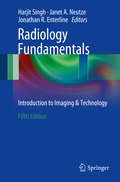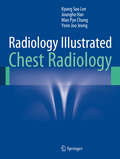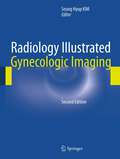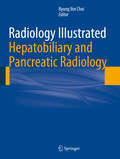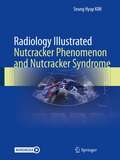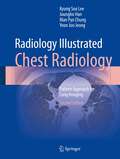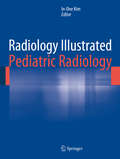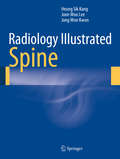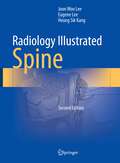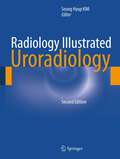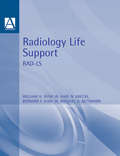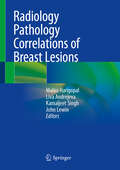- Table View
- List View
Radiological Interventions in Obstetrics and Gynaecology
by John Reidy Nigel Hacking Bruce MclucasThis book provides a state-of-the-art review of the technical and clinical aspects of the vascular interventional radiological (IR) procedures currently employed in obstetrics and gynaecology. A particular focus is on uterine artery embolisation for fibroid disease, which is contrasted with the main alternative uterus-conserving surgical approach of myomectomy, and with ablation therapy. Detailed consideration is also given to the role of embolisation in a variety of other less common conditions, including arteriovenous malformations, post-partum haemorrhage, abnormal placentation and pelvic congestion syndrome. IR procedures are examined from a critical gynaecological perspective and with regard to surgical alternatives. The authors include leading interventional radiologists and gynaecologists from the United Kingdom, Europe and North America.
Radiological Interventions in Obstetrics and Gynaecology (Medical Radiology)
by John Reidy Nigel Hacking Bruce McLucasThis book provides a state-of-the-art review of the technical and clinical aspects of the vascular interventional radiological (IR) procedures currently employed in obstetrics and gynaecology. A particular focus is on uterine artery embolisation for fibroid disease, which is contrasted with the main alternative uterus-conserving surgical approach of myomectomy, and with ablation therapy. Detailed consideration is also given to the role of embolisation in a variety of other less common conditions, including arteriovenous malformations, post-partum haemorrhage, abnormal placentation and pelvic congestion syndrome. IR procedures are examined from a critical gynaecological perspective and with regard to surgical alternatives. The authors include leading interventional radiologists and gynaecologists from the United Kingdom, Europe and North America.
Radiological Safety and Quality
by Lawrence Lau Kwan-Hoong NgThis book is the product of a unique collaboration by experts from leading international, regional and national agencies and professional organizations discussing on the current 'hot' issue on the judicious use and safety of radiation in radiology. There have been several cases involving radiation overexposure that have received international attention. Strategies and solutions to guide readers how to maximize the benefits and minimize the risks when using radiation in medicine are covered.
Radiological Sciences Dictionary: Keywords, names and definitions
by David DowsettThe Radiological Sciences Dictionary is a rapid reference guide for all hospital staff employed in diagnostic imaging, providing definitions of over 3000 keywords as applied to the technology of diagnostic radiology.Written in a concise and easy to digest form, the dictionary covers a wide variety of subject matter, including:a radiation legislati
Radiological and Nuclear Terrorism: Their Science, Effects, Prevention, and Recovery (Advanced Sciences and Technologies for Security Applications)
by P. Andrew KaramThis book discusses multiple aspects of radiological and nuclear terrorism. Do you know what to do if there is a radiological or nuclear emergency in your city? These accidents are not common, but they have happened – and even though we have not seen an attack using these weapons, governments around the world are making plans for how to prevent them – and for how to respond if necessary. Whether you are an emergency responder, a medical caregiver, a public health official – even a member of the public wanting to know how to keep yourself and your loved ones safe – there is a need to understand how these weapons work, how radiation affects our health, how to stop an attack from taking place, how to respond appropriately in the event of an emergency, and much more.Unfortunately, the knowledge that is needed to accomplish all of this is lacking at all levels of society and government. In this book, Dr. Andrew Karam, an internationally respected expert in radiation safety and multiple aspects of radiological and nuclear emergencies, discusses how these weapons work and what they can do, how they can affect our health, how to keep yourself safe, and how to react appropriately whether you are a police officer investigating a suspect radiological weapon, a firefighter responding to a radiological or nuclear attack, a nurse or physician caring for potentially contaminated patients, or a governmental official trying to keep the public safe. To do this, he draws upon his extensive experience in the military, the several years he worked directly with emergency responders, his service on a number of advisory committees, and multiple trips overseas in the aftermath of the Fukushima accident and on behalf of the International Atomic Energy Agency, Interpol, and the Health Physics Society.
Radiologie: Techniek en onderzoek
by Jacques Hensen Karen Jaarsveld-Bolman Tom Dam José Dol-Jansen Sija Geers-van GemerenRadiologie maakt deel uit van de serie Medische Beeldvorming en Radiotherapie. De uitgave van deze boeken is een initiatief van het project Samenwerkingsverband Leermiddelen, in samenwerking met de redacties en auteurs uit het werkveld. Dit boek is een vervolg op en afgeleid van de boeken Techniek in de radiologie en Radiodiagnostisch onderzoek. Vanaf 2010 zijn deze twee boeken vervangen door drie delen, die sterk zijn uitgebreid en geactualiseerd:Computertomografie, Radiologie en Magnetic Resonance Imaging. Radiologie bevat een beschrijving van de r#65533;ntgentechniek en instelkunde, en daarnaast een overzicht van belangrijke ontwikkelingen op het gebied van digitalisering en kwaliteitsaspecten van het beroepsveld van de MBB'er (Medisch Beeldvormings- en Bestralingsdeskundige). Deel 1 Techniek beschrijft het basisprincipe van de radiologie en de toepassing hiervan in de praktijk. Nieuwe technische begrippen komen uitgebreid aan bod. Deel 2 gaat in op de strenge eisen op het gebied van kwaliteit en veiligheid die zowel aan de r#65533;ntgenapparatuur als aan de MBB'ers worden gesteld, waarbij ook de pati#65533;ntveiligheid aan bod komt. Deel 3 geeft een uitvoerige beschrijving van de instellingen voor het maken van standaardr#65533;ntgenopnamen met alle benodigde gegevens, ondersteund door fotomateriaal en illustraties. Hierbij is een onderverdeling gemaakt per tractus. Verder is er speciale aandacht voor mammografie, traumatologie en r#65533;ntgenonderzoek bij kinderen. Behalve voor MBB'ers in opleiding is Radiologie ook bij uitstek geschikt voor MBB'ers werkzaam in de radiologie, nucleaire geneeskunde en radiotherapie. Het boek is ook een goede introductie voor radiologen, al dan niet in opleiding, en een betrouwbaar naslagwerk voor artsen in opleiding.
Radiologie: Techniek en onderzoek (Medische beeldvorming en radiotherapie)
by Jacques Hensen Tom Dam John PeetersDit boek beschrijft de röntgentechniek en instelkunde, en geeft een overzicht van belangrijke ontwikkelingen op het gebied van digitalisering en kwaliteitsaspecten van het beroepsveld van de MBB’er (Medisch Beeldvormings- en Bestralingsdeskundige). Deel 1 gaat in op het basisprincipe van de radiologie en de toepassing hiervan in de praktijk. Nieuwe technische begrippen komen uitgebreid aan bod. Deel 2 benoemt de strenge eisen op het gebied van kwaliteit en veiligheid die aan de röntgenapparatuur en aan de MBB’ers worden gesteld, waarbij ook de patiëntveiligheid aan bod komt. Deel 3 beschrijft de instellingen voor het maken van standaardröntgenopnamen met alle benodigde gegevens, ondersteund door fotomateriaal en illustraties. Er is een onderverdeling gemaakt per tractus. Verder is er speciale aandacht voor mammografie, traumatologie en röntgenonderzoek bij kinderen. Deze volledig herziene editie is geactualiseerd en aangepast volgens de huidige maatstaven. De techniek is op sommige punten verder ontwikkeld, er zijn verschillende nieuwe onderzoeken bij gekomen en andere onderzoeken zijn obsoleet geworden of vervangen door andere technieken zoals MRI, CT of echografie.Online zijn de teksten en afbeeldingen van het boek ook te raadplegen. Bij dit boek hoort een website die het mogelijk maakt om altijd en overal te studeren of informatie op te zoeken. Ook zijn hier oefenvragen per hoofdstuk beschikbaar die het mogelijk maken om verworven competenties en kennis te toetsen. Radiologie – Techniek en onderzoek maakt deel uit van de serie Medische Beeldvorming en Radiotherapie. Behalve voor MBB’ers in opleiding is dit boek bij uitstek geschikt voor MBB’ers werkzaam in de radiologie, nucleaire geneeskunde en radiotherapie. Het boek is ook een goede introductie voor radiologen, al dan niet in opleiding, en een betrouwbaar naslagwerk voor artsen in opleiding.
Radiology 101: The Basics and Fundamentals of Imaging
by Thomas A. FarrellWith over 35,000 copies of the first 4 editions sold, Radiology 101 introduces diagnostic imaging to non-radiologists; medical students, individuals on a radiology rotation, as well as PA and nursing students. As in previous editions, there is coverage of normal anatomy, commonly encountered diseases and their radiological manifestations with up to date clinical content relevant to those studying for the USMLE. Each chapter includes an outline, highlighted important information and an end of chapter Question and Answer section. Throughout the book, emphasis is placed on what exam to order with extensive referencing to the ACR Appropriateness Criteria© which will assume new importance as the basis for evidence based clinical decision support when ordering imaging in the near future.
Radiology Cases for Medical Student OSCEs (Masterpass Ser.)
by Debbie WaiRadiology now forms part of the core curriculum and is assessed in the final medical OSCE. This book includes 100 radiology cases that medical students are likely to encounter in their exams. The book is primarily image based, presenting a clinical history, description of findings and discussion for each image. Critically, the images include modern techniques such as CT and MRI in addition to more traditional photography, and the book helps students recognise and interpret abnormal image findings as well as increasing their factual knowledge. This book is vital reading for final year medical students approaching their final OSCE, and also for junior doctors who need a radiology quick reference guide in clinical practice. It can also be used to supplement MRCS Picture Questions Book 1 (see below) by candidates revising for the MRCS examination.
Radiology Education
by Kathryn M. Hibbert Rethy K. Chhem Teresa van Van Deven Shih-Chang WangThis book reviews the philosophies, theories, and principles that underpin assessment and evaluation in radiology education, highlighting emerging practices and work done in the field. The sometimes conflicting assessment and evaluation needs of accreditation bodies, academic programs, trainees, and patients are carefully considered. The final section of the book examines assessment and evaluation in practice, through the development of rich case studies reflecting the implementation of a variety of approaches. This is the third book in a trilogy devoted to radiology education. The previous two books focused on the culture and the learning organizations in which our future radiologists are educated and on the application of educational principles in the education of radiologists. Here, the trilogy comes full circle: attending to the assessment and evaluation of the education of its members has much to offer back to the learning of the organization.
Radiology Fundamentals
by Harjit Singh Janet NeutzeRadiology Fundamentals is a concise introduction to the dynamic field of radiology for medical students, non-radiology house staff, physician assistants, nurse practitioners, radiology assistants, and other allied health professionals. The goal of the book is to provide readers with general examples and brief discussions of basic radiographic principles and to serve as a curriculum guide, supplementing a radiology education and providing a solid foundation for further learning. Introductory chapters provide readers with the fundamental scientific concepts underlying the medical use of imaging modalities and technology, including ultrasound, computed tomography, magnetic resonance imaging, and nuclear medicine. The main scope of the book is to present concise chapters organized by anatomic region and radiology sub-specialty that highlight the radiologist's role in diagnosing and treating common diseases, disorders, and conditions. Highly illustrated with images and diagrams, each chapter in Radiology Fundamentals begins with learning objectives to aid readers in recognizing important points and connecting the basic radiology concepts that run throughout the text. It is the editors' hope that this valuable, up-to-date resource will foster and further stimulate self-directed radiology learning--the process at the heart of medical education.
Radiology Fundamentals
by Harjit Singh Janet A. Neutze Jonathan R. EnterlineThis book serves as a introduction to the dynamic field of radiology for medical students, non-radiology house staff, physician assistants, nurse practitioners, radiology assistants, and other allied health professionals and provides information that ranges from basic radiographic principles to advanced imaging techniques. It begins with a discussion of the fundamental concepts underlying the medical use of imaging modalities such as ultrasound, computed tomography, magnetic resonance imaging, and nuclear medicine. Subsequent chapters are organized by anatomic region and imaging modality that highlight the radiologist's role in diagnosing and treating common disorders. Each chapter offers learning objectives to aid readers in recognizing important points and connecting the basic radiology concepts. The fifth edition is thoroughly updated and includes new or expanded chapters on nuclear medicine, pediatric radiology, and emerging imaging techniques. A comprehensive question bank, which functions as a valuable self-assessment tool, concludes the book.
Radiology Fundamentals: Introduction to Imaging & Technology
by Harjit Singh Janet A. Neutze Jennifer KissaneThis book serves as an introduction to the dynamic field of radiology for medical students, non-radiology house staff, physician assistants, nurse practitioners, radiology assistants, and other allied health professionals and provides information that ranges from basic radiographic principles to advanced imaging techniques. It begins with a discussion of the fundamental concepts underlying the medical use of imaging modalities such as ultrasound, computed tomography, magnetic resonance imaging, and nuclear medicine. Subsequent chapters are organized by anatomic region and imaging modality that highlight the radiologist’s role in diagnosing and treating common disorders. Each chapter offers learning objectives to aid readers in recognizing important points and connecting the basic radiology concepts. The sixth edition is thoroughly updated. The editors and authors introduce the approach to SAFE radiology, explaining the concepts of S-safety in all modalities, A-appropriateness of imaging ordering, F-interpreting films and E-acting expeditiously on significant findings and executing the recommendation of the imaging findings. Easy to learn and easy to remember, SAFE reminds all health care professionals that safety and appropriateness should precede any imaging testing and that all results should be applied expeditiously and thoughtfully.
Radiology Illustrated: Chest Radiology
by Kyung Soo Lee Joungho Han Man Pyo Chung Yeon Joo JeongThe purpose of this atlas is to illustrate how to achieve reliable diagnoses when confronted by the different abnormalities, or "disease patterns", that may be visualized on CT scans of the chest. The task of pattern recognition has been greatly facilitated by the advent of multidetector CT (MDCT), and the focus of the book is very much on the role of state-of-the-art MDCT. A wide range of disease patterns and distributions are covered, with emphasis on the typical imaging characteristics of the various focal and diffuse lung diseases. In addition, clinical information relevant to differential diagnosis is provided and the underlying gross and microscopic pathology is depicted, permitting CT-pathology correlation. The entire information relevant to each disease pattern is also tabulated for ease of reference. This book will be an invaluable handy tool that will enable the reader to quickly and easily reach a diagnosis appropriate to the pattern of lung abnormality identified on CT scans.
Radiology Illustrated: Gastrointestinal Tract
by Byung Ihn ChoiRadiology Illustrated: Gastrointestinal Tract is the second of two volumes designed to provide clear and practical guidance on the diagnostic imaging of abdominal diseases. The book presents approximately 300 cases with 1500 carefully selected and categorized illustrations of gastrointestinal tract diseases, along with key text messages and tables that will help the reader easily to recall the relevant images as an aid to differential diagnosis. Essential points are summarized at the end of each text message to facilitate rapid review and learning. Additionally, brief descriptions of each clinical problem are provided, followed by case studies of both common and uncommon pathologies that illustrate the roles of the different imaging modalities, including ultrasound, radiography, computed tomography, and magnetic resonance imaging.
Radiology Illustrated: Gynecologic Imaging
by Seung Hyup KimRadiology Illustrated: Gynecologic Imaging is an up-to-date, image-oriented reference in the style of a teaching file that has been designed specifically to be of value in clinical practice. Individual chapters focus on the various imaging techniques, normal variants and congenital anomalies, and the full range of pathology. Each chapter starts with a concise overview, and abundant examples of the imaging findings are then presented. In this second edition, the range and quality of the illustrations have been enhanced, and image quality is excellent throughout. Many schematic drawings have been added to help readers memorize characteristic imaging findings through pattern recognition. The organization of chapters by disease entity will enable readers quickly to find the information they seek. Besides serving as an outstanding aid to differential diagnosis, this book will provide a user-friendly review tool for certification or recertification in radiology.
Radiology Illustrated: Hepatobiliary and Pancreatic Radiology
by Byung Ihn ChoiRadiology Illustrated: Hepatobiliary and Pancreatic Radiology is the first of two volumes that will serve as a clear, practical guide to the diagnostic imaging of abdominal diseases. This volume, devoted to diseases of the liver, biliary tree, gallbladder, pancreas, and spleen, covers congenital disorders, vascular diseases, benign and malignant tumors, and infectious conditions. Liver transplantation, evaluation of the therapeutic response of hepatocellular carcinoma, trauma, and post-treatment complications are also addressed. The book presents approximately 560 cases with more than 2100 carefully selected and categorized illustrations, along with key text messages and tables, that will allow the reader easily to recall the relevant images as an aid to differential diagnosis. At the end of each text message, key points are summarized to facilitate rapid review and learning. In addition, brief descriptions of each clinical problem are provided, followed by both common and uncommon case studies that illustrate the role of different imaging modalities, such as ultrasound, radiography, CT, and MRI.
Radiology Illustrated: Nutcracker Phenomenon and Nutcracker Syndrome (Radiology Illustrated)
by Seung Hyup KimThe nutcracker phenomenon (NCP) is an accentuated phenomenon of normal subtle compression of the left renal vein (LRV) between the abdominal aorta and superior mesenteric artery. The nutcracker syndrome (NCS) is a syndrome caused by NCP, resulting in hematuria, proteinuria, or left flank pain. The established diagnostic criterion of NCP is a pressure gradient more than 3 mmHG across the compression site, and NCS has been known to be rare, but probably is not rare and in fact quite common. The most important reason why NCS is known to be rare is that the diagnosis is difficult unless invasive venous catheterization and pressure measurement confirm the pressure gradient. Doppler ultrasound is useful in measuring the flow velocity of LRV. From the velocity measured by Doppler ultrasound, we may estimate the pressure gradient. Doppler ultrasound of LRV needs technical skills and experience. Computed tomography (CT) is a popular imaging technique for patients with hematuria, and we need to be familiar with the findings of the NCP at CT. There are variations of NCP associated with vascular anatomy and posture of the patients. This book will illustrate the concepts of NCP and NCS, findings at Doppler ultrasound and CT, and variations of NCP.
Radiology Illustrated: Pattern Approach for Lung Imaging (Radiology Illustrated)
by Kyung Soo Lee Joungho Han Man Pyo Chung Yeon Joo JeongThe purpose of this atlas is to illustrate how to achieve reliable diagnoses when confronted by the different abnormalities, or “disease patterns”, that may be visualized on CT scans of the chest. The task of pattern recognition has been greatly facilitated by the advent of high-technology CT such as helical and multidetector CT (MDCT) and dual-energy CT (DECT), and the focus of the book is very much on the role of state-of-the-art MDCT. A wide range of disease patterns and distributions are covered, with emphasis on the typical imaging characteristics of the various focal and diffuse lung diseases. In addition, clinical information relevant to differential diagnosis is provided and the underlying gross and microscopic pathology is depicted, permitting CT–pathology correlation. The entire information relevant to each disease pattern is also tabulated for ease of reference. This book will be an invaluable handy tool that will enable the reader to quickly and easily reach a diagnosis appropriate to the pattern of lung abnormality identified on CT scans. And in this second edition, some more signs and several new diseases and their pattern have been developed and updated. They will be provided with imaging, clinical relevance and CT-pathology correlation. Moreover, the chapters and disease patterns in their order of presentation shall be somewhat changed for readers’ easy legibility and understanding.
Radiology Illustrated: Pediatric Radiology
by In-One KimThis case-based atlas presents images depicting the findings typically observed when imaging a variety of common and uncommon diseases in the pediatric age group. The cases are organized according to anatomic region, covering disorders of the brain, spinal cord, head and neck, chest, cardiovascular system, gastrointestinal system, genitourinary system, and musculoskeletal system. Cases are presented in a form resembling teaching files, and the images are accompanied by concise informative text. The goal is to provide a diagnostic reference suitable for use in daily routine by both practicing radiologists and radiology residents or fellows. The atlas will also serve as a teaching aide and a study resource, and will offer pediatricians and surgeons guidance on the clinical applications of pediatric imaging.
Radiology Illustrated: Spine
by Heung Sik Kang Joon Woo Lee Jong Won KwonRadiology Illustrated: Spine is an up-to-date, superbly illustrated reference in the style of a teaching file that has been designed specifically to be of value in clinical practice. Common, critical, and rare but distinctive spinal disorders are described succinctly with the aid of images highlighting important features and informative schematic illustrations. The first part of the book, on common spinal disorders, is for radiology residents and other clinicians who are embarking on the interpretation of spinal images. A range of key disorders are then presented, including infectious spondylitis, cervical trauma, spinal cord disorders, spinal tumors, congenital disorders, uncommon degenerative disorders, inflammatory arthritides, and vascular malformations. The third part is devoted to rare but clinically significant spinal disorders with characteristic imaging features, and the book closes by presenting practical tips that will assist in the interpretation of confusing cases.
Radiology Illustrated: Spine (Radiology Illustrated)
by Heung Sik Kang Joon Woo Lee Eugene LeeRadiology Illustrated: Spine is an up-to-date, superbly illustrated reference in the style of a teaching file that has been designed specifically to be of value in clinical practice. Common, critical, and rare but distinctive spinal disorders are described succinctly with the aid of images highlighting important features and informative schematic illustrations. The first part of the book, on common spinal disorders, is for radiology residents and other clinicians who are embarking on the interpretation of spinal images. A range of key disorders are then presented, including infectious spondylitis, cervical trauma, spinal cord disorders, spinal tumors, congenital disorders, uncommon degenerative disorders, inflammatory arthritides, and vascular malformations. The third part is devoted to rare but clinically significant spinal disorders with characteristic imaging features, and the book closes by presenting practical tips that will assist in the interpretation of confusing cases.The second edition is covering updated knowledge about spine imaging interpretation, such as disc nomenclature version 2.0, AO classification for spine trauma, neuromyelitis optica spectrum disorders, covid-19 vaccine related spine disorders, etc. In addition, new edition show a lot of highly qualified spine imaging obtained by recently developed CT and MR machine of high-end technology. A lot of interesting cases representing characteristic imaging features is newly included in the third part.
Radiology Illustrated: Uroradiology
by Seung Hyup KimUroradiology is an up-to-date, image-oriented reference in the style of a teaching file that has been designed specifically to be of value in clinical practice. All aspects of the imaging of urologic diseases are covered, and case studies illustrate the findings obtained with the relevant imaging modalities in both common and uncommon conditions. Most chapters focus on a particular clinical problem, but normal findings, congenital anomalies, and interventions are also discussed and illustrated. In this second edition, the range and quality of the illustrations have been enhanced, and many schematic drawings have been added to help readers memorize characteristic imaging findings through pattern recognition. The accompanying text is concise and informative. Besides serving as an outstanding aid to differential diagnosis, this book will provide a user-friendly review tool for certification or recertification in radiology.
Radiology Life Support (RAD-LS): A Practical Approach
by William Bush Jr'Radiology Life Support' focuses on the adverse effects and life-threatening emergencies caused by reactions to the contrast media used in every modern radiology department. Such reactions are relatively infrequent yet can be severe and are therefore difficult to identify and then handle safely without training. All radiologists will experience at least a few such reactions throughout their career. This book teaches proper recognition and treatment of adverse contrast reactions, proper use of sedation and analgesic agents, proper management of an airway in an emergency situation and principle concepts in basic and advanced life support (including early defibrilation). The text is based on the successful training course run by the editors and sponsored by the American Roentgen Ray Society. Adverse reactions to contrast agents are somewhat difficult for physicians without practice to identify and then handle effectively. This volume is a useful aid to the identification process.
Radiology Pathology Correlations of Breast Lesions
by John Lewin Kamaljeet Singh Malini Harigopal Liva AndrejevaThis book brings together the expertise of nationally renowned radiologists and pathologists in resolving difficult breast lesions detected on imaging. While there are several separate resources available for radiology residents to study imaging modalities, there are few if any books that illustrate simultaneous radiology pathology correlates. This text will be a useful reference for residents, fellows, and practicing attendings in both disciplines. As the two disciplines of radiology and pathology are interrelated, the scope of the book is to provide and inform readers of not only typical examples of breast lesions that correlate with imaging findings that may or may not require surgical excision but also to resolve problematic lesions that are discordant with imaging findings. This book contains 14 chapters containing hundreds of images supplemented with key references. These chapters include outlines with systematic approaches to each disease entity punctuated by various imaging techniques, key diagnostic points seen on imaging, and pathology followed by differential diagnostic considerations. Finally, a summary of concordant and discordant findings is provided at the end of each section. Written by experts in the fields of radiology and pathology, as well as surgical colleagues that manage patients with breast diseases, Radiology Pathology Correlations of Breast Lesions serves as an easy-to-use reference for radiology and pathology residents and fellows, as well as practicing pathologists and radiologists. This book integrates the radiologic and pathologic appearance of relatively common breast lesions side-by-side with easy-to-understand descriptions and illustrations.
